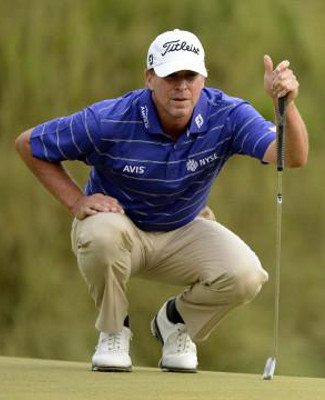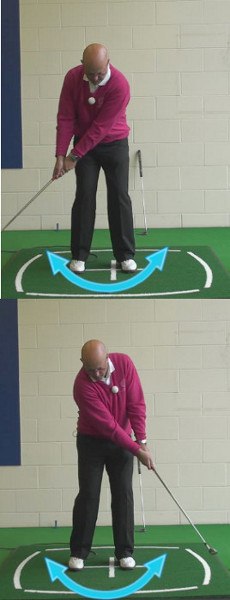 What a career it’s been for Steve Stricker.
What a career it’s been for Steve Stricker.
He’s the only golfer to earn the PGA Tour’s Comeback Player of the Year award twice, overcoming injury and swing issues to emerge as one of the world’s best. Even more amazingly, the proud Wisconsin native has done most of his damage since turning 40 in 2007.
Ask the average fan what makes Stricker so successful, and they’ll likely credit his putting. Indeed, Stricker is one of the game’s finest on the greens. But his long game is not to be overlooked, especially since Stricker’s swing is one of the simplest actions you’ll find among tour pros.
Stricker’s move: Keeps wrists firm, with minimal wrist cock, throughout the backswing.
Who else does it: Byron Nelson
When most pros reach the point where the left arm is parallel to the ground, they’ve hinged the wrists to place the shaft at or near vertical. Not Stricker. His shaft points at about a 45° angle to the left arm. Stricker says he focuses on keeping the wrists firm and rotating his left arm, which ensures an on-plane swing.
You see much the same thing in Stricker’s downswing. In contrast to the whip-crack action many pros unleash at impact, Stricker’s wrists are very quiet. He’s not the longest driver out there – in fact, Stricker ranked just 113th in driving distance for 2011 – but most of us would settle for an average of 288.8 yards off the tee.
Why it works: The best thing about Stricker’s swing is its simplicity. Because the big muscles of his shoulders, hips and torso are in control, Stricker is less reliant than other golfers on impeccable timing. It’s also an easily repeatable motion, making Stricker’s swing quite reliable under pressure.
How it can work for you: Plenty of amateurs overuse the hands and wrists in an effort to create power. They start the backswing by quickly jerking the clubhead away from the ball, then cast the head abruptly downward from the top.
If yours is an overly handsy swing, concentrate on the first few inches going back (the takeaway). Simply start the swing by moving the left arm and shoulder (for a right-handed golfer) in unison. There’s no need to worry about the wrists hinging on the way up. As long as your forearms rotate naturally, the wrists will follow suit.
One word of caution: Don’t take Stricker’s mental key of keeping the wrists firm too literally. Firm is fine, but stiff is another matter, and may result from a conscious effort to maintain firmness. Focus on those big-muscle motions and the rest will take care of itself.

Steve Stricker Uses a Specific Formula to Play Great Golf
What do you picture when you think about the best golfers in the world? Perhaps players who bomb the ball easily over 300 yards in the air, using long and aggressive swings? While there are plenty of those out there, another category of golfer exists that is just as effective while using a completely different strategy. Outsmarting the golf course is still possible even in the age of long drives and short rough, and Steve Stricker is a perfect example of executing just such a tactic.
If you scan the PGA Tour driving distance leaderboards, you will need to scroll down a while before you find the name of Steve Stricker. Generally ranked 100 or lower in driving distance, power is not the name of the game for the Steve Stricker PGA Tour career. Rather, Stricker uses incredible prowess on the putting green, along with accurate ball striking and good decision making to shoot low score and contend in big tournaments. The Steve Stricker golfer that fans have come to appreciate over the years is one who does it his own way, and has been amazingly successful.
As far as major championship go, the Steve Stricker PGA Championship performance at Sahalee Country Club in 1998 remains his best career effort. In that event, Stricker finished second to Vijay Singh. Beyond that tournament, Stricker has eleven other top-10 finishes in majors, including four at the U.S. Open. Most recently, a Steve Stricker PGA Championship of T7 in 2014 gave him is highest position in a major since accomplishing that same finish in 2012. While Stricker has not yet been able to capture a major title of his own, he does hold an impressive mark that speaks to the consistency of his game – of the 63 major championships that he has entered, he has made the cut 49 times.
Of course, it shouldn’t be a surprise that someone with a game like Stricker’s would be consistent in the biggest events. There simply isn’t a whole lot that can go wrong with the Stricker swing, and the Steve Stricker putter is obviously a great advantage over the field. Players who sacrifice power in the name of accuracy and control tend to be highly consistent, and that is certainly true in this case.
Watching Steve Stricker putting during any PGA Tour event makes it easy to understand how he has built such a successful pro career.
There are countless lessons that the average golfer can learn from the game of Steve Stricker. Since most amateurs don’t possess the power or explosiveness of some of the big hitters that the Tour has to offer, it is a much better idea to observe the game of a player like Stricker to find valuable lessons that can be applied to your own swing or putting stroke. By paying careful attention to some of the things that Stricker does so well, your own game could quickly benefit as a result.

The Magic Putter, Steve Stricker
It isn’t fair to call Steve Stricker’s putter ‘magic’, because he has certainly put in countless hours of hard work to become the great putter that he is. However, it is hard to avoid that word when you watch him roll the ball during a Tour event. He has a great touch, repeatable mechanics, and top-notch green reading skills. Add it all up, and you get one of the very best putters in the world. If you are looking for a player to model your own putting stroke after, Stricker is a hard choice to beat.
Just like with the full swing, there are plenty of different ways to make a putting stroke and have it work effectively. Even among the top players in the world, it is easy to see plenty of differences in mechanics and styles – yet all of them have managed to get to the top of the pro game. With that said, the Steve Stricker putting stroke looks like it was taken right out of the pages of an instructional book. Quite simply, it looks to be perfect. It is obvious that a lot of time and effort has gone into building this stroke, because it is so technically sound and repeatable putt after putt. Having great mechanics doesn’t guarantee that a putt will go in the hole, but it sure is a great place to start from.
The first of the many things that Stricker does well with his putting stroke is establishing a single plane between the shaft of the club and his forearms. When viewed from behind, the putter looks to be running directly up into his hands and forearms on a single, straight line. This setup position wouldn’t be a great idea when setting up for a full swing, but it is great for putting purposes. Having a one-plane setup running from your putter head up into your elbows simplifies the whole process and takes away potential moving parts.
Essentially, using this setup style will take your hands and wrists out of the stroke as much as possible. Since most golfers will be best served by rocking the putter back and through using their shoulders, getting the hands out of the stroke is a great place to start. If you watch Stricker hit some putts, you will see that there is almost no movement other than the rocking of his shoulders. It is this beautiful simplicity that allows him to have the consistency he does – which leads to great results round after round. Many people make the mistake of thinking that putting is a matter of having some good days and some bad days, but a player like Stricker proves that simply isn’t true. When a simple stroke is mastered, putting becomes far more predictable.
Another putting fundamental that Stricker seems to have mastered is the tempo of the stroke back and through. In many amateur putting strokes – and even some in the professional ranks – there will be a noticeable change in tempo at some point during the motion. That is not the case with Stricker. He rocks the putter back and through with incredible consistency, making it easy to imagine how he controls the speed of his putts so well. Good tempo makes it easier to hit putts the right distance, easier to hit them in the sweet spot of the putter face, and easier to hold up under pressure. All of the things that most golfers struggle with on the putting green can be improved on simply by focusing on a great tempo.
The final putting fundamental that we will highlight in regard to Stricker’s technique is his mostly upright stance at address. This is another one of those mechanics that isn’t great for a full swing, but is excellent on the putting green. By standing up tall and using all of his six foot frame, Stricker is able to get a good look at the line he is putting on each and every time. Standing hunched over the ball makes it much harder to see the line correctly and get aligned with your target accurately. If you feel like aim is a problem within your putting game, make an effort to stand up taller at address and you should quickly improve in that regard.

Straight Back, Straight Through, Steve Stricker
There are two distinct camps when it comes to the right way to swing a putter – on an arc, or straight back and straight through the ball. The ‘arc’ putting stroke is meant to resemble a full golf swing in that the putter face opens during the backstroke and then releases through impact, with the hope that the blade will be perfectly square when you hit the ball. The straight back, straight through method, however, is the one that Steve Stricker appears to use by watching his stroke. There is very little rotation of the putter face, and the plane that he has established with the putter shaft and his forearms allows for the club to swing in nearly a straight line toward the target.
The upright stance that was mentioned above is another element in Stricker’s putting stroke that helps to make this linear stroke possible. One of the unique things about his technique is the position of the putter head relative to the ground prior to hitting a putt. Instead of having the putter soled flat on the grass, Stricker has the heel of the putter up in the air slightly at address. While this isn’t necessarily an element that you need to copy, it does go to show how upright the putter is and how vertical he is with his setup position. There is a danger in setting up in this manner in that you might have trouble getting the putter face in exactly the right position to hit your target line, but that is obviously a problem that Steve Stricker does not have.
So, when it comes to your own game, should you use the straight back and straight through method, or is an arc stroke a better option? For most golfers, the Stricker approach is going to be the better one to take. While you can find plenty of players on Tour – including many highly successful ones – who use an arc stroke, the straight back and straight through model is the easier one to execute. There is less timing and fewer moving parts with this approach, meaning that it is easier for the weekend golfer to emulate. When in doubt in terms of your own golf game, opt for the simpler option that will require less timing and less practice to work for you.
If you do decide to work on the straight back and straight through method in your own putting stroke, make sure to pay attention to the following three points.
- Find the right length putter. If you use a putter that is too short in terms of overall length, it will be hard to execute this putting style. For the average golfer, a putter of 35’’ will usually be a pretty good fit. If you move down toward putters that are 32’’ or 33’’, it will get harder and harder to swing the putter head on a straight line because you won’t be able to get your forearms and the putter shaft on the same plane. You should be able to stand up tall over the ball and address and not have to hunch over at the back to reach your putter.
- No hands in the stroke. Using hands and wrists in your stroke is going to make the putter head arc. To avoid that outcome, make sure you are using only your shoulders to rock the putter back and through the ball. If you are someone who has previously used a lot of hands in your putting stroke, this will take some practice to get used to. However, it will pay off in the end when you are able to consistently roll the ball perfectly on your target line.
- Eyes on the ball! This one applies to any kind of putting stroke you happen to be using. It is crucial that you make solid contact with the ball, and that is only going to happen if you are able to keep your eyes on the ball all the way through the stroke. Resist the temptation to look up early and focus your eyes on the top of the ball until it has rolled away.
It is hard to copy the full swing of a Tour player – or any other golfer – but it is easier to copy their putting stroke. If you would like to change your putting technique in an effort to make more putts on a regular basis, you won’t find a better model than Steve Stricker.

Not Just a Great Putter, Steve Stricker
While putting might be the first thing that people think of, the Stricker swing is nothing to ignore either. You don’t become the quality of player that Steve Stricker golfer has been without a great swing to go along with the well-known putting skills. The PGA Tour is too competitive for a player to survive on just putting alone – it takes a well-rounded, overall game in order to find long term success. Just like with his putting stroke, there is plenty you can learn from the Stricker swing.
As mentioned above, Stricker is not the longest hitter on the PGA Tour, or even among the top 100. He is outdriven by the majority of his playing competitors, and yet he often rises near the top of the leaderboard by the end of the week. When you watch him swing the club, that lack of power is not surprising. In many ways, his full swing actually resembles his putting stroke – controlled, balanced, and consistent. Just like with the putting stroke, Stricker doesn’t use hit hands excessively in the full swing. Instead, he uses shoulder and body rotation to move the club through the hitting zone. This explains the shorter distance compared to others on Tour, but also explains the consistency and accuracy that he is able to achieve.
Among the first things you will notice in his golf swing is the short backswing that he uses throughout the bag. In a time when many golfers are taking the club all the way to parallel and beyond in order to generate speed, Stricker usually stops short of that position. As a result, his swing always looks to be on balance and he strikes the ball cleanly time after time. Even when hitting a driver, there is an obvious focus on control and precision instead of sheer power. This is a lesson that almost every golfer could stand to learn from. Sure power is nice, but control and accuracy is far more useful.
It isn’t a great idea to simply copy the swing of another golfer, and you shouldn’t try to swing exactly like Steve Stricker because you have your own natural tendencies and mechanics that aren’t going to change easily. However, you can pick parts of his swing to incorporate into your own game as a way of making small improvements that can quickly add up over time. Consider using one or more of the three following features of Stricker’s swing as you get to work on your own technique.
- Balance. If you aren’t already working on your balance during the golf swing, now is the time. This might be the single most important element within any golf swing, because it affects so many other areas of the game. Steve Stricker has great balance throughout his swing, and you should strive for similar control.
- Quiet feet. Many amateur golfers get in trouble by moving their feet all around during the swing. Stricker does a beautiful job of keeping his feet quiet throughout the swing, which likely contributes to the excellent balanced mentioned above. When it comes to footwork, pay specific attention to your lead foot at impact – it should be firmly planted on the ground giving you a strong platform to hit from.
- Rhythm. One of the things that stands out in watching Stricker’s swing is the absence of any kind of rushing or hurrying in his technique. Everything happens in proper sequence, and there seems to be no anxiousness to get the ball into the air. Countless amateur players rush through their swings only to harm their mechanics and decrease the quality of their ball striking overall. Focus on an even tempo and remember that there is no rush to hit the ball – let your swing gather speed naturally and gradually up until impact.

Learning from the Best, Steve Stricker
Any golf fan will know that the Steve Stricker putter is one of the most valuable and dangerous weapons on the PGA Tour. Not only would any amateur golfer love to be able to putt like Stricker, many of his fellow professionals would as well. However, there is more to the story than just great performance on the putting green – it is a solid overall game and smarts on the course that has led Stricker to such heights throughout his notable pro career.
As has been highlighted above, there is plenty that you can stand to learn from Stricker’s game. In many ways, he is a perfect model for the average golfer to emulate because he is so fundamentally sound on all of his shots. He doesn’t try to overpower the golf course with sheer strength – rather, he hits smart shots and accurate putts while trying to keep his golf ball in position at all times. For most golfers, this is exactly the approach that they should be taking in their own games. If you find yourself frequently looking through the trees or into the water hazards for your golf ball, perhaps taking the Stricker approach could benefit your scores.
Of course, that will be easier said than done. Stricker is an accomplished professional who has been among the best in the world for a long time – it would be a disservice to him to suggest that you can simply copy what he does and instantly play great golf. It isn’t that easy. However, there are many fundamentals that you can find within his game that should apply directly to your own. Even by just sharpening up one or two parts of your technique based on what you observe in Stricker’s game, you should make yourself a better player rather quickly.
Regardless of how your own style of golf matches up with that of Steve Stricker, there is no doubt that he is a fun player to watch simply due to his reliable performance and incredible putting ability. While Stricker no longer plays a full PGA Tour schedule, he remains a fan favorite and is always a threat to be high on the leaderboard when he does choose to compete. Take some time to watch video of Stricker hitting full shots and putts, and then take what you can to add into your own technique.







